The Maths — No Problem! 2026 Whakawhitinga Edition

Because New Zealand's learners deserve extraordinary.
→ Simple.
→ Powerful.
→ Award-winning.
→ Unmistakably New Zealand.
Join our webinar to find out more.
Adapted for Aotearoa New Zealand and further aligned for 2026 to meet Te Mātaiaho, the Refreshed Curriculum.
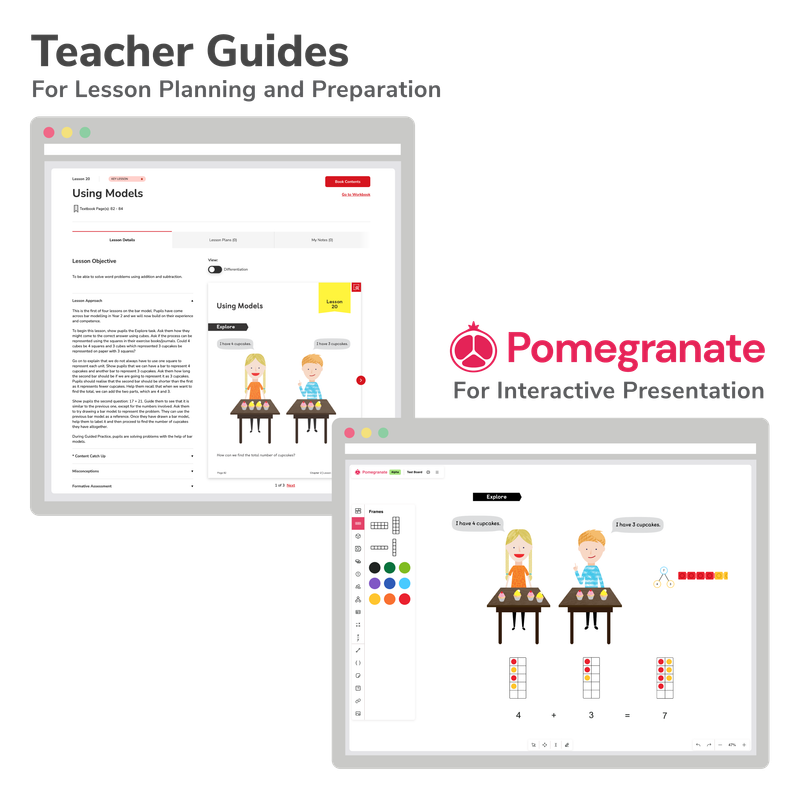
For Teachers
Essential teaching tools:
Comprehensive Teacher Guides streamline lesson planning, while Bridging Guides ensure smooth level transitions.
The interactive presentation tools within Pomegranate captivate students with dynamic visuals, empowering educators to deliver impactful mathematics instruction with confidence and ease.
The 28 video courses in the Fundamentals Online Course are designed to help teachers understand how to teach with the Maths — No Problem! series.
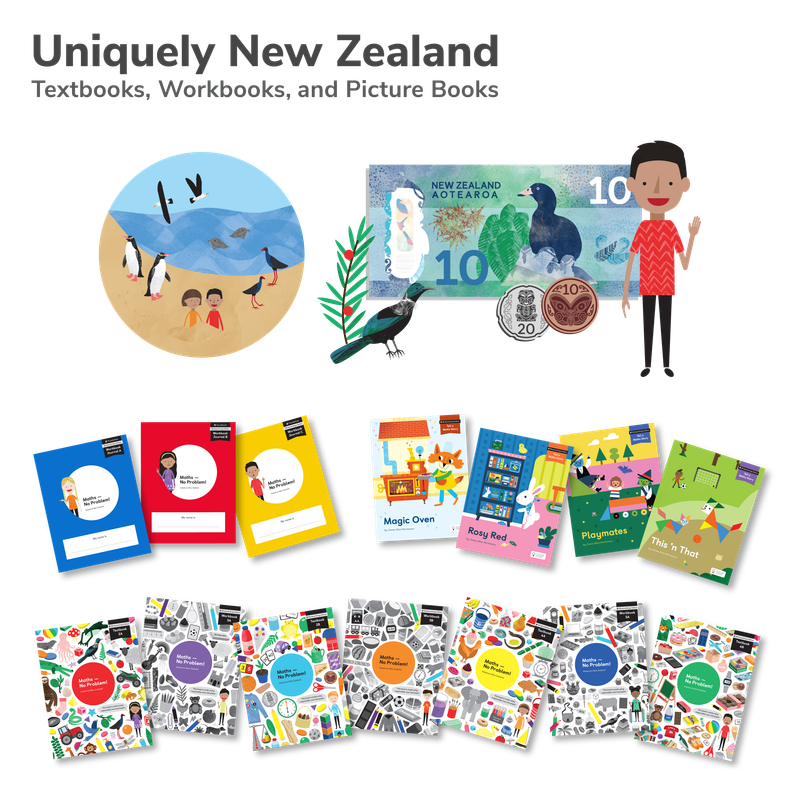
For Students
Essential learning resources:
Engaging Textbooks present concepts clearly and reinforce learning, while practice-oriented Workbooks offer opportunities to apply knowledge through carefully varied questions that build relational understanding.
For younger children:
Maths Reading Books introduce concepts through engaging stories. Workbook Journals combine exercises with reflective writing, encouraging thought expression, and progress tracking.
Redefining excellence in mathematics, one classroom at a time.
Created with teachers in mind, because we believe every educator deserves the tools to inspire mathematical brilliance with confidence and ease.
Equipped with professional-grade resources and cutting-edge instruments, you can make a real difference for all the children in your school while you confidently deliver the new Te Mataiaho Curriculum.
For Teachers
Because every educator deserves cutting-edge tools to inspire mathematical brilliance with assurance and simplicity.

Confidence
Your Teacher Guides instil confidence by providing you with credible and comprehensive details to deliver effective lessons to the whole class with conviction every time.
→ Masterfully Crafted by Experienced Experts
→ Clear, Consistent and Coherent Guidance
→ Efficiency-Bolstering Plans and Particulars

Clarity
Your Curriculum Guide allows you to plan a pathway for your students to the new curriculum, highlighting where to find crystal clear evidence of every sequence step.
→ Know which lessons meet each sequence step in the curriculum
→ Prioritise and map content
→ Navigate by Curriculum Objectives or by Lessons

Trust
Partner with the Maths — No Problem! community for its proven track record of enhancing student achievement and benefit from a commitment to teacher satisfaction.
→ Crafted for you — the Teachers
→ Trusted by Millions of Children Worldwide
→ Backed by Evidence, Built on Research
How It Works
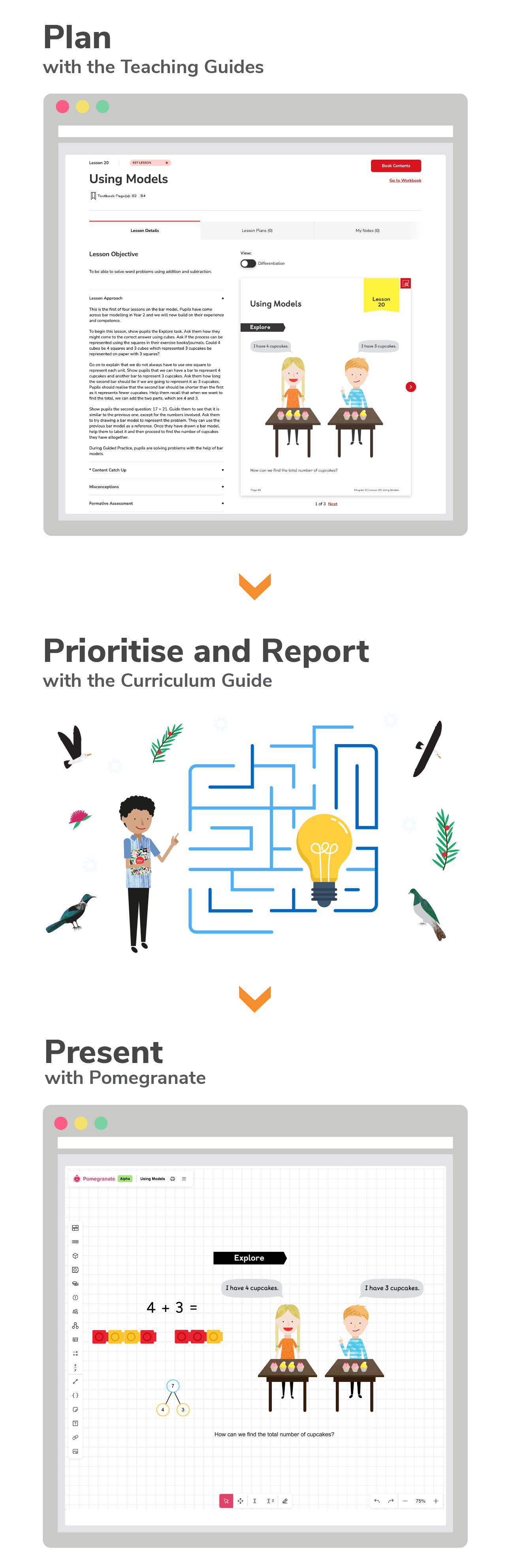


1. Teacher Guides
Confident Teachers Teach Brilliantly
Support for educators reimagined
With intuitive planning and streamlined guidance, the Teacher Guides support you with effortless lesson preparation. The guides include innovative pedagogy with cutting-edge teaching methods to inspire strong learning. Assistance is integrated into the guides for seamless support and a fluid teaching experience. Access formative assessment tools for real-time insight into student understanding to transform your practice.
Streamlined lesson planning: Guides for each lesson provide essential planning information, teaching approaches, and solutions to common misconceptions — includes variation techniques, curriculum alignment, and suggested resources.
Formative assessment: Tools to evaluate student understanding and guide lesson progression.
Teacher empowerment: Carefully designed guides boost confidence in delivering effective maths instruction.
Comprehensive support: Access worked answers for all questions and a concise Getting Started guide for efficient Teacher Guides navigation.
Differentiation: Teacher Guides provide specific lesson guidance to support struggling and advanced learners. Workbook Mind Challenges give advanced learners an extra challenge and the Mathsteasers books (separate purchase) offer a another level of learning.
Fundamentals course: A 28-video series offering insights into Maths — No Problem! methodology, enhancing educators' ability to deliver effective maths lessons.
Parent Section: Videos for parents that you can put on your school website.
Parent Resources: Worked answers, downloadables, and printable worksheets (allowing books to stay at school).
2. Curriculum Guide
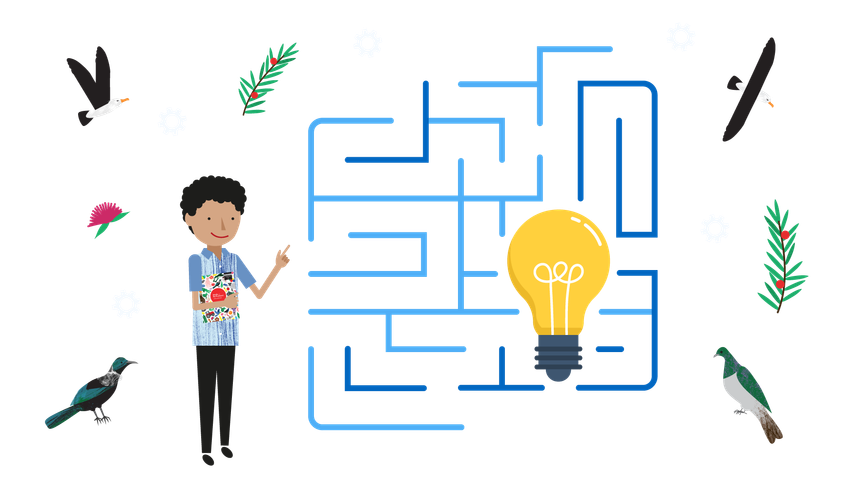
Seamless Transitions, Limitless Potential
Effortlessly navigate curriculum changes while still meeting pupils individual needs.
The Maths — No Problem! suite of resources is designed to offer teachers and students support as they navigate the changes in curriculum and practice.
Comprehensive Coverage: Maps across all content to ensure all curriculum are met.
Tool for reporting: Arranged in sequence steps with the lessons that meet each step listed beneath providing a clear map of evidence for teachers and reporting.
Extension Support: Additional Mathsteasers resources are available which are designed specifically for advanced learners to provide opportunities for further challenge beyond the core series.
Lesson Classification: Every lesson has a classification label to show the lesson prioritsation level.
Smooth Transition: Aims to ease the transition for both teachers and students while providing support to meet individual and whole class needs.
3. Pomegranate: Maths, Illuminated
Simplify. Engage. Inspire.
Sleek, intuitive presentation tool that brings mathematics to life.
Transform your mathematics lessons into sophisticated, immersive experiences that spark curiosity and nurture deep understanding.
Captivating Visuals: Breathe life into mathematical concepts with elegant, vibrant graphics that effortlessly capture attention and deepen understanding.
Seamless Interaction: Encourage active learning through fluid touch interactions, intuitive gestures, and smooth concept demonstrations.
Perfect Harmony: Flawlessly integrated with our curriculum, Pomegranate creates a unified, coherent learning journey.
Tailored Experience: Effortlessly adapt presentations to your unique style, ensuring a personalized approach for every classroom.
Instant Insights: Seamlessly incorporate quick checks to gauge understanding in real-time, enabling fluid, responsive instruction.
4. Fundamentals Course
Master Your Craft
Access clear, engaging video courses that will transform your teaching.
Unlock the full potential of Maths — No Problem with our intuitive Fundamentals course. Designed with the elegance and simplicity you expect from us, this series of 28 video lessons seamlessly guides you through our innovative approach. Transform your teaching, inspire your students, and redefine mathematics education — all at your fingertips.
Comprehensive Course: Dive into our 28-video Fundamentals course which offers a thorough exploration of the Maths — No Problem! methodology and its practical application in the classroom.
User-Friendly Format: Navigate through bite-sized video lessons with ease, designed to accommodate educators' busy schedules and varying levels of experience.
Real-World Application: Observe seasoned educators demonstrating key concepts and strategies, bridging the gap between theory and practice in mathematics instruction.
Self-Paced Learning: Tailor your professional development journey by progressing through the course at your own speed, with the flexibility to revisit content as needed.
Ongoing Resources: Access a growing library of supplementary materials and updates, ensuring your Maths — No Problem! skills remain current and effective.
For Students
Because every child deserves the best opportunities in life.

Deep conceptual understanding
Through the spiral curriculum and the emphasis on problem-solving, students develop a profound grasp of mathematical concepts rather than just memorizing procedures.

Confidence and resilience
By revisiting and expanding on topics, learners build confidence in their mathematical abilities and develop resilience when faced with challenging problems.

Critical thinking skills
The focus on real-world problem-solving and high-level reasoning nurtures students' critical thinking abilities, preparing them to be innovative thinkers beyond the maths classroom.
How It Works



1. Early Years Wonder: Where Maths Begins
Years 0 and 1
For our youngest learners, we've crafted a magical world of numbers. Our resources blend seamlessly with early learning principles, nurturing pre-numeracy skills through enchanting stories, playful adventures, and tactile explorations.
It's not just maths; it's the first step in a lifelong journey of discovery.
Foundations Picture Books: A Visual Journey into Mathematics
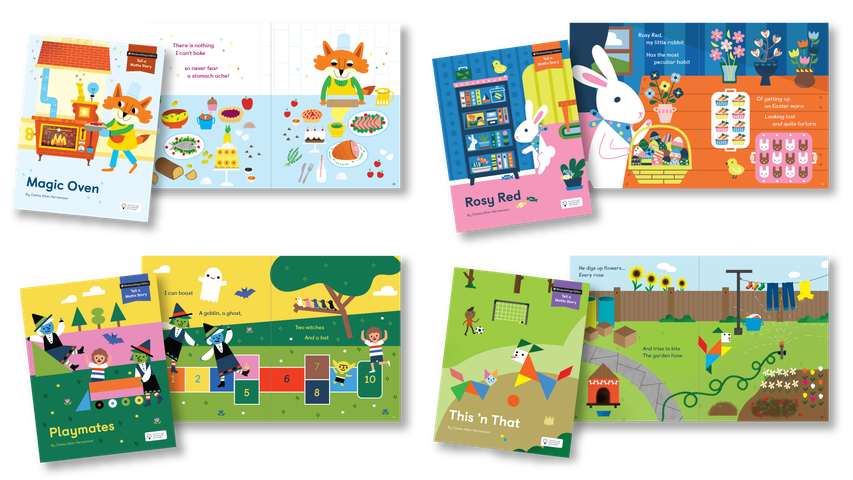
Embark on a mathematical adventure with James Alan Hermanson's enchanting picture book series.
Expertly crafted with input from Series Consultant Yeap Ban Har, these visually stunning books weave core mathematical concepts into captivating stories.
Perfect for young learners, they make maths exploration a magical journey.
Mathematical Concepts: The stories subtly introduce core mathematical ideas through visual cues and storytelling.
Rich Illustrations: Painstakingly crafted visuals bring the magical worlds to life, enhancing the learning experience.
Interactive Elements: The books offer opportunities for games and exploration, encouraging active engagement with mathematical concepts.
Diverse Characters: From tangram cats to brilliant bunnies, the books feature a range of charming characters that appeal to young readers.
Multi-Concept Learning: Each book covers multiple mathematical ideas, providing a comprehensive introduction to foundational maths skills.
Foundations Workbook Journals: Hands-on Practice for Mathematical Mastery

Transform mathematical concepts into practical skills through fun, thoughtfully designed exercises.
These carefully designed workbooks provide hands-on practice to reinforce the mathematical concepts introduced in the picture books.
Image-focused design: The workbooks prioritize visual elements over text to reduce cognitive load for early learners.
Deep mastery approach: Activities are developed to provide direct access to core mathematical principles.
Comprehensive coverage: Three workbook journals cover the entire school year.
Regular practice: The journals provide two activities per week.
Practical application: Suggested activities utilize equipment and real-world items found in classrooms.
Progressive content: Each workbook (A, B, and C) covers different topics, gradually introducing more complex concepts.
2. Where Mathematical Mastery Flourishes
Years 2 to 8
Our carefully designed curriculum spirals through these formative years, transforming young minds into confident problem-solvers. With each concept revisited and expanded, students don't just learn maths — they master it.
It's not just education; it's the art of nurturing tomorrow's innovators and critical thinkers.
Textbooks: Elevate Your Learning
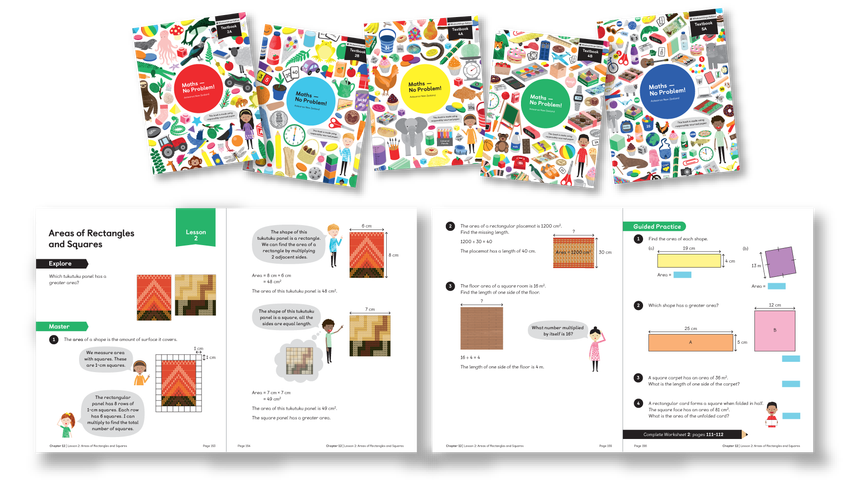
More than just textbooks, these are the cornerstones of a transformative mathematical experience.
Discover a world of mathematical brilliance with our meticulously crafted textbooks. Each page is an invitation to explore, innovate, and master the art of numbers.
Integrated seamlessly with our suite of learning tools, they create an ecosystem where mastery isn't just achieved — it's inevitable.
Intuitive Lessons: Sleek, streamlined content that builds understanding with precision.
Innovative Problem-Solving: Engaging challenges that spark creativity and critical thinking.
Stunning Visuals: Minimalist diagrams and models that illuminate complex concepts.
Seamless Progression: A fluid journey through topics, each revisit adding depth and nuance.
Refined Practice: Carefully curated exercises that hone skills with elegance.
Thoughtful Reflection: Insightful prompts that encourage deep, meaningful learning.
Workbooks: Refine Your Skills
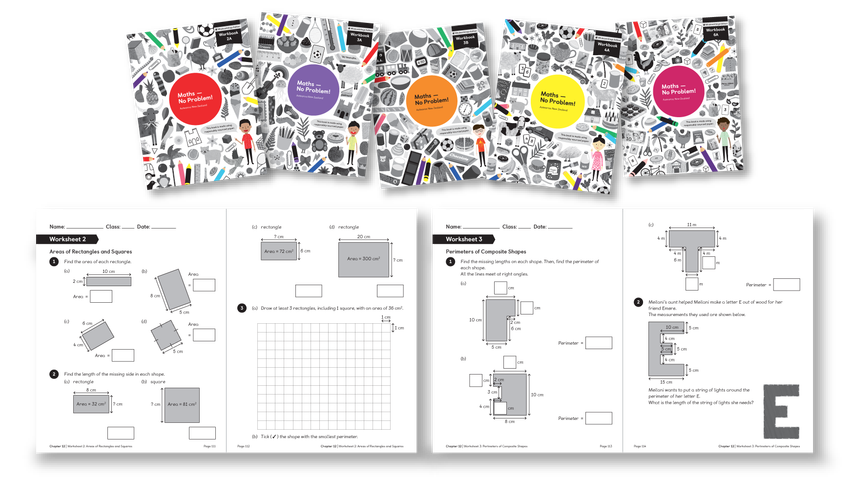
More than just a companion to the textbooks — they're an essential part of the learning experience.
The independent practice section is a cornerstone of our workbooks, embodying the principle of variation. Here, students encounter:
Mathematical Variation: Problems that subtly shift in complexity and approach, deepening understanding.
Embodiment Variation: Diverse conceptual representations of mathematical concepts, fostering a profound grasp of mathematical principles.
Varied Challenges: Problems that evolve through mathematical and embodiment variation, deepening understanding.
Thoughtful Progression: A seamless flow from knowing to applying to reasoning.
Elegant Exercises: Carefully curated problems that challenge and inspire.
Minimalist Design: Clean layouts that focus attention on what matters most.
Reflective Spaces: Areas for notes and insights, encouraging metacognition.
Visual Thinking: Opportunities to sketch and model mathematical ideas.
How It Works
Because every educator deserves cutting-edge tools to inspire mathematical brilliance with assurance and simplicity.
The Maths — No Problem! Programme
Watch an in-depth video on the methodology behind the Maths — No Problem! award-winning programme.
Download Sample Textbook and Workbook Lessons.
Phase 1

Years 0 and 1 Topics Can Include:
Matching, sorting, comparing, and ordering objects and numbers
Recognizing and creating simple patterns (AB, AAB, ABC)
Counting forwards and backwards
Understanding positional language
Introduction to basic operations: addition, subtraction, and concepts of halving and sharing
Exploring number bonds
Using five and ten frames
Identifying odd and even numbers
Basic geometry
Measurement concepts: time, capacity, length, and mass
Introduction to data collection and representation
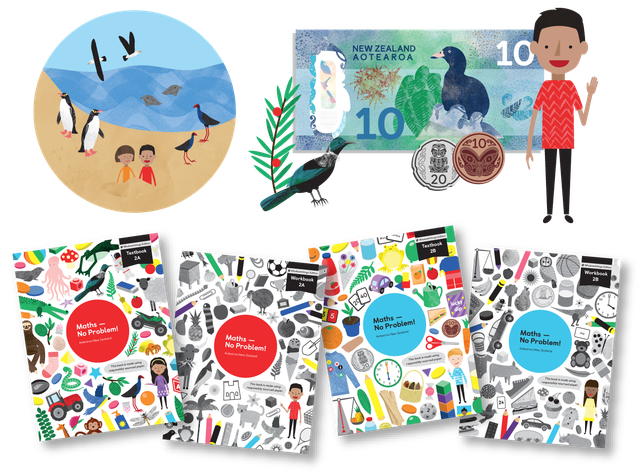
Year 2 Topics Can Include:
Numbers and Counting: Covers place value, including counting, writing, comparing, and ordering
Addition and Subtraction: Introduces various strategies for adding and subtracting, including number bonds and word problems
Multiplication and Division: Basic concepts of skip counting, equal groups, sharing, and doubling
Fractions: Introduction to halves, quarters and eighths, sharing and grouping, and finding the whole
Geometry: Includes recognizing shapes, patterns, and positions
Measurement: Covers length, height, time, money, volume, capacity, and mass
Problem-solving: Incorporates word problems and practical applications throughout various topics
Probability: Understanding chance, predicting outcomes and comparing results
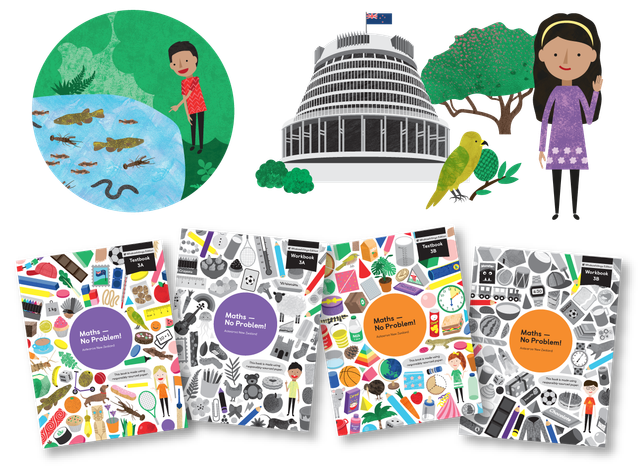
Year 3 Topics Include:
Numbers and Counting: Counting, place value to 1000, comparing numbers, number bonds, and patterns
Addition and Subtraction: Simple adding and subtracting, renaming, and working with three numbers
Multiplication and Division: Focus on times tables, equal groups, sharing, and odd/even numbers
Measurement: Length (metres and centimetres), mass (kilograms and grams), temperature, and volume (litres and millilitres)
Money: Writing amounts, counting, comparing, calculating totals and change
Geometry: Two-dimensional and three-dimensional shapes, including sides, vertices, symmetry, and patterns
Fractions: Equal parts, naming, representing, comparing and ordering fractions
Time: Telling time to 5 minutes, durations, and sequencing events
Data Handling: Reading and interpreting graphs, and conducting investigations
Problem Solving: Word problems integrated throughout various topics
Phase 2
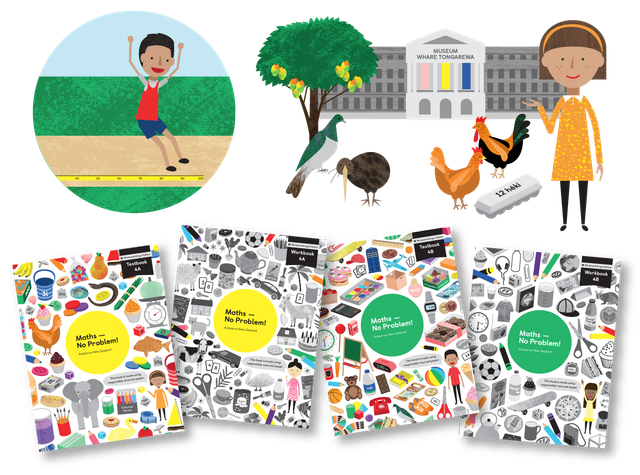
Year 4 Topics Include:
Rounding Numbers: Focuses on rounding whole numbers
Numbers and Counting: Place value to 10,000, number bonds, recognising and recording, comparing and ordering
Operations: Extensive coverage of addition and subtraction of three digit numbers, estimation, multiplication and division of up to three-digit numbers, focus on multiplication and division facts
Financial Maths: Includes naming amounts, showing amounts, adding and subtracting money, and calculating change
Time: Covers telling time, measuring time in seconds, minutes, and hours, and converting between units
Statistics: Teaches investigating, drawing, reading and analyzing various types of graphs
Fractions: Extensive coverage including counting in tenths, equivalent fractions, comparing fractions, and solving word problems
Angles: Introduces angle concepts, identifying angles, and comparing angles
Shapes: Covers 2D and 3D shapes
Measurement: comparing, measuring, and converting, solving word problems involving length, mass and capacity
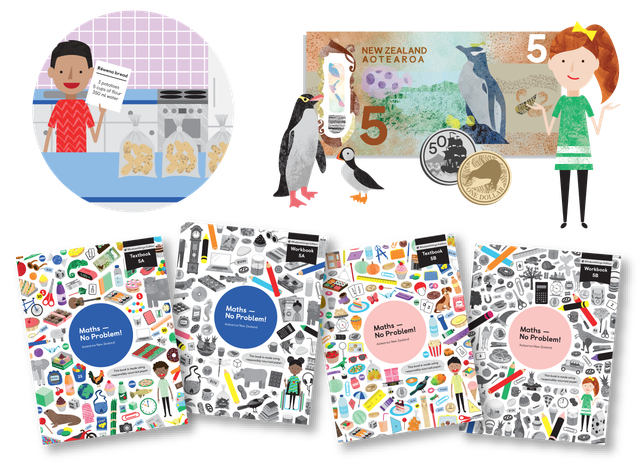
Year 5 Topics Include:
Numbers and Operations: Further addition, subtraction, multiplication and division, including multi-digit numbers
Statistics: Drawing, investigating, analysing and reading pictograms, bar graphs, and line graphs.
Fractions: Equivalent fractions, mixed numbers, adding and subtracting fractions
Time: 24-hour clock, time conversions, and duration problems
Decimals: Writing tenths and hundredths, comparing and ordering decimals
Financial Maths: Writing, comparing, and rounding amounts, solving money problems
Measurement: Length, mass, and volume conversions and estimations
Geometry: Angles, triangles, quadrilaterals, symmetry, and shape classification
Position and Movement: Plotting points and describing translations
Probability: Predicted frequency, theoretical and experimental probabilities
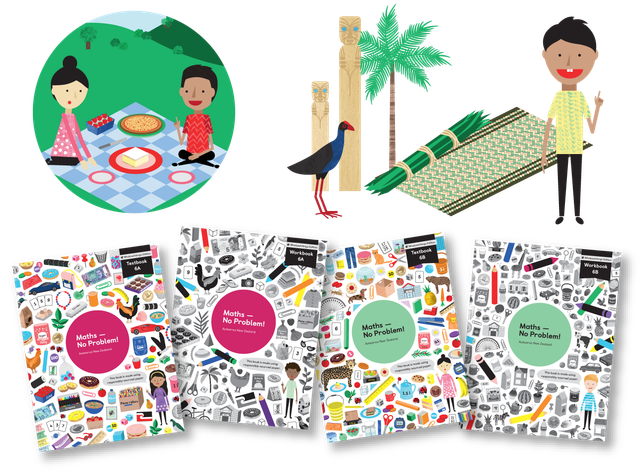
Year 6 Topics Include:
Whole Numbers: Operations with numbers up to 1,000,000, including addition, subtraction, multiplication, division, place value and operators
Fractions: Improper fractions, mixed numbers, equivalent fractions, comparing and ordering fractions, and operations with fractions
Decimals: Reading, writing, comparing, and performing operations with decimals
Percentages: Writing percentages, converting between fractions, decimals, and percentages
Statistics: Reading, investigating, planning, analysing and interpreting various types of graphs, including tables and line graphs
Geometry: Types of angles, measuring angles, and drawing lines and angles
Algebra: Show patterns, find and describe rules, use rules to make predictions
Probability: Express probability of an event, Solve a problem involving probability
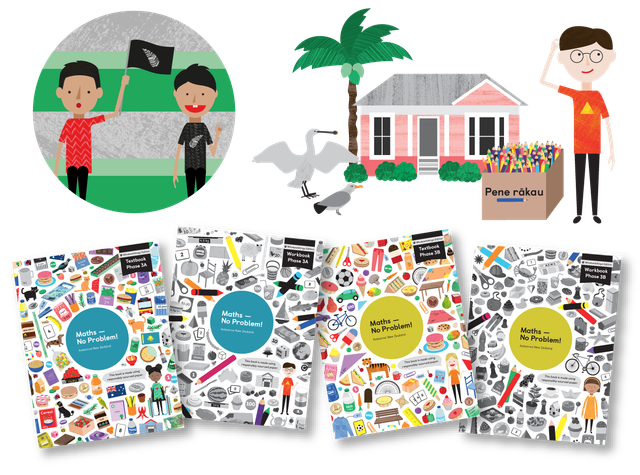
Years 7 and 8 Topics Include:
Numbers and Operations: Place value, whole numbers, decimals, percentages, ratio, and negative numbers
Algebra: Patterns, algebraic expressions, formulae, and equations
Geometry: Area, perimeter, volume, angles, circles, and 3D shapes
Financial maths: Calculating total cost and change, applying discounts, comparing payment plans and budgeting
Measurement: Converting units of length, mass, volume, and time
Statistics and Probability: Averages (mean), pie charts, and line graphs
Problem Solving: Word problems involving various mathematical concepts
(Lessons will be explicitly classified as Year 7 or Year 8)
What Schools Get
Existing Maths — No Problem! schools:
→ Teacher Hub subscription
→ Pomegranate subscription
→ Student Workbooks
→ Foundations Workbook Journals
New Maths — No Problem! schools:
→ Teacher Hub subscription
→ Pomegranate subscription
→ Textbooks
→ Student Workbooks
→ Foundations Picture Books
→ Foundations Workbook Journals
Beyond the Series

Best Practice Schools
Driven by an army of best practice schools, there is a lot more support when you are a Maths — No Problem! school, including a community network for schools to help each other. Find the New Zealand schools already using Maths — No Problem!

Professional Development
We provide free training to setup schools for success. We also offer customized training at additional cost, tailored to your staff and students' needs. Our expert trainers offer workshops, demo lessons, and collaborative planning to help teachers effectively implement Maths — No Problem! in their classrooms.

Support For Schools
Maths — No Problem! has been used by millions of children and has trained thousands of teachers. Just ask — We are here to help.
Testimonials
FAQs
Does the series cover the entire Te Mātaiaho, the New Zealand curriculum?
The series follows the goals of the Te Mātaiaho, the New Zealand curriculum, ensuring a comprehensive and enriched mathematical education.
When is the best time to start?
The best time to start is now, as there is no need to wait to implement the very best mathematics education programme. Meet with one of our representatives to start your Maths — No Problem! journey towards success.
Can Maths — No Problem! be used with composite classes?
Yes, the programme is adaptable for composite classes, offering differentiation strategies and support for teaching multiple year groups simultaneously.
Can the maths lessons still be creative and engaging?
Absolutely! Yes! Maths — No Problem! encourages creativity and student-led learning, providing a framework for exploration and interactive problem-solving.
Do Maths — No Problem! schools see improved results?
New Zealand schools using Maths — No Problem! have reported significant improvements in student achievement and engagement. The mastery approach helps build deep understanding, leading to better long-term results and increased confidence in mathematics.
How does the programme handle diverse abilities in a class?
Maths — No Problem! supports differentiation with extension activities for advanced learners and additional support for those who need it. This allows all students to progress at their own pace while working on the same core concepts.
Can Maths — No Problem! be used alongside other resources?
While comprehensive, many schools use the Maths — No Problem! programme as their core maths curriculum and supplement it with additional resources as needed.
How does Maths — No Problem! support schools implementing the approach?
Maths — No Problem! provides comprehensive professional development through workshops, webinars, and ongoing expert guidance to assist schools throughout the implementation process.
How does Maths — No Problem! support whānau engagement?
Maths — No Problem! provides parent guides and resources to help whānau understand and support their child's learning. We also offer suggestions for home activities that reinforce classroom learning and encourage family involvement.
How does Maths — No Problem! support students with additional learning needs (SEN)?
The programme offers strategies for diverse learners, including those with additional needs. For example, the CPA (Concrete, Pictorial, Abstract) approach benefits students who struggle with traditional methods.
Is there support for ESOL students?
Your ESOL students will benefit from our visual approach and focus on mathematical vocabulary. Your teachers will get strategies to support language development, helping your students build mathematical literacy alongside numeracy skills.
What is maths mastery and how is the approach supported?
Maths mastery develops deep conceptual understanding. This is supported through sequenced lessons, problem-solving focus, and progression from concrete to pictorial to abstract concepts.
Is Maths — No Problem! aligned with Te Mātaiaho?
The programme is specifically tailored to align with Te Mātaiaho, the New Zealand curriculum, covering all required content areas and supporting the development of key competencies outlined in the curriculum.